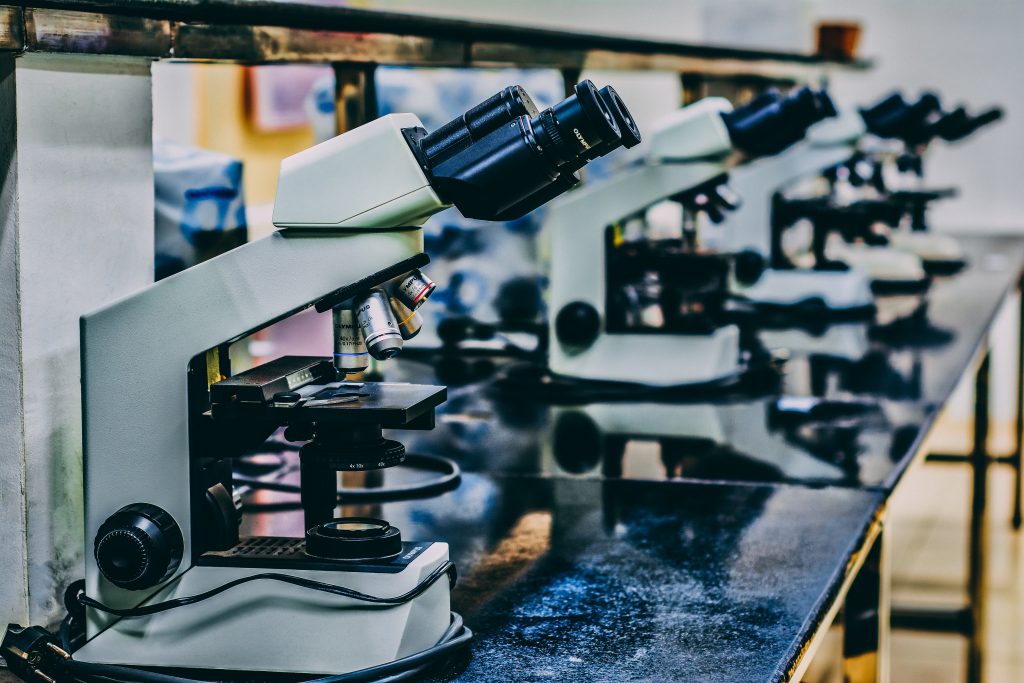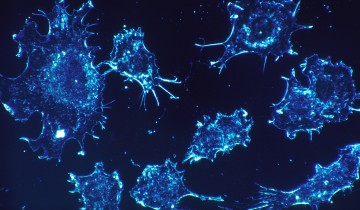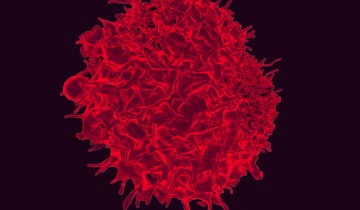Molecular sensors enable eukaryotes to recognize microbial pathogens and their products, thus operating as major players in the protective mechanisms of the innate immune response. In addition to microbial pathogens, innate molecular sensors recognize signals from damaged tissues. The response of innate molecular sensors is typically immediate but short-lived. However, excessive activation and/or engagement of sensors by self molecules (as in the case of damaged tissues) may induce autoimmunity and other inflammatory disorders.
A study published in 2019 in the scientific journal eLife highlights a new function for one of these sensors. The sensor, called NLRP12, is a member of the NOD-like family of pattern recognition receptors, and is located in the cytosol of innate immune cells. It is also known to be a critical regulator of inflammation and cancer. The new study (NLRP12 suppresses hepatocellular carcinoma via downregulation of cJun N-terminal kinase activation in the hepatocyte) shows that NLRP12 has a protective effect against hepatocellular carcinoma, a deadly human cancer.
Hepatocellular carcinoma is the most common type of primary liver cancer. It occurs most often in people with chronic liver diseases, such as cirrhosis caused by hepatitis B or hepatitis C infection, and in people who drink large amounts of alcohol and who have an accumulation of fat in the liver. Although the precise mechanisms through which these conditions induce liver cancer are unknown, chronic inflammation in the liver is considered a key player.
For the study, researchers exposed mice that were missing the Nlrp12 gene to a chemical carcinogen. Results show that these mice exhibit higher levels of inflammation and increased tumor development compared with normal mice. Therefore, the researchers examined the signals sent by tumor cells in mice with and without the Nlrp12 gene. They found that the JNK (c-Jun N-terminal kinase) pathway, which is known to be associated with liver cancer, is highly active in liver tumors that lack Nlrp12.
The JNK pathway is usually activated by a component of bacterial cell walls called lipopolysaccharide (LPS). Both “good” bacteria (which line the gut and aid in digestion) and “bad” pathogenic bacteria are able to release LPS. Once released, LPS can travel from the gut to the liver via the bloodstream. In the liver, LPS can participate to the development of inflammation by setting off the JNK and other signaling pathways. LPS transport is much more common in chronically inflamed livers such as those of people suffering from hepatitis or fatty liver disease.
All together, these results suggest that NLRP12 suppresses inflammation caused by gut microbiota, and inhibits cancer-promoting signals and proliferation of hepatocytes.
To confirm the gut-liver inflammation-cancer hypothesis, the researchers treated mice with antibiotics to reduce levels of gut bacteria. Dr. Hasan Zaki, senior author of the study, said in a press release: “Depletion of gut microbiota with antibiotics dramatically reduced tumor growth in mice without Nlrp12. This study suggests that NLRP12 could be a potential therapeutic target. It also indicates that finding a way to increase NLRP12 in the liver in combination with current immune checkpoint blockade therapies may improve liver cancer treatment.”




In the article “Innate Immune Responses: A Molecular Sensor Suppresses Liver Cancer,” they use the NLRP12 sensor to combat against hepatocellular carcinoma, a deadly human cancer. After reading the article, the question I asked myself was, “what else can NLRP12 being used for?” After a good amount of reading, I came across a scientific article, “NLRP12 collaborates with NLRP3 and NLRC4 to promote pyroptosis inducing ganglion cell death of acute glaucoma.” In this paper, the scientists were able to use NLRP12 collaborates with NLRP3 and NLRC4 to program cell death of acute glaucoma cells. For this to be done, the scientist had to use antibodies to target proteins that would heighten pyroptosis. The study’s results conclude that with the collaborative effects of NLRP12, NLRP3 and NLRC4 on pyroptosis are responsible for acute glaucoma cell death.
References
Chen H;Deng Y;Gan X;Li Y;Huang W;Lu L;Wei L;Su L;Luo J;Zou B;Hong Y;Cao Y;Liu Y;Chi W; “NLRP12 Collaborates With NLRP3 and NLRC4 to Promote Pyroptosis Inducing Ganglion Cell Death of Acute Glaucoma.” Molecular Neurodegeneration, U.S. National Library of Medicine, pubmed.ncbi.nlm.nih.gov/32295623/.
Skringer,
While reading the overall blog post, I thought it was interesting that NLRP12 is used as a regulator to suppress inflammation and blocks cancer signals in the liver, in turn, suppressing liver cancer. Then after reading your post, I thought it was even more fascinating that it not only helps with liver cancer, but it is also beneficial in acute glaucoma cell death. This led me to further research on what other diseases benefit from the regulatory effects of NLRP12. After researching, I found the article “NLRP12 suppresses colon inflammation and tumorigenesis through the negative regulation of noncanonical NF-κB signaling and MAP Kinase Activation,” which also illuminates the benefits of NLRP12. In this article, researchers found that NLRP12 is used to suppress colon inflammation and tumorigeneses. In the article, scientists found that mice who lacked NLRP12 cells were more likely to get colon cancer than the mice who did not. To do this, they studied the effects of NLRP12 on NF-κB, which is responsible for colon inflammation. They found that NLRP12 inhibits NF-κB by seeing how in comparison to the control group, the mice who lacked NLRP12 had more of a buildup of leukocytes and mucosal inflammation, proving that NLRP12 downregulates inflammation. In this article, they also found that when introduced to colon cancer mice who lacked NLRP12, showed an increase in the proinflammatory cytokines, and cytokines such as Interleukin 1Beta. This helped prove that the presence of NLRP12 helps with the suppression of tumorigenesis. This research along with your research, and the research found in the blog post are essential because to reiterate the blog post, understanding the benefits of NLRP12 can be helpful in cancer treatment in the future. This also makes me question what other forms of cancer does NLRP12 help regulate, and what in fact, does it help regulate in those different forms.
Reference:
https://www.ncbi.nlm.nih.gov/pmc/articles/PMC3658309/
Allen, I. C., Wilson, J. E., Schneider, M., Lich, J. D., Roberts, R. A., Arthur, J. C., Woodford, R. M., Davis, B. K., Uronis, J. M., Herfarth, H. H., Jobin, C., Rogers, A. B., & Ting, J. P. (2012). NLRP12 suppresses colon inflammation and tumorigenesis through the negative regulation of noncanonical NF-κB signaling. Immunity, 36(5), 742–754. https://doi.org/10.1016/j.immuni.2012.03.012
NLRP12 is a critical component of innate immune cells and aids to suppresses inflammation. NLRP12 is essential to the immune system ad can be very essential to all sorts of NLRP!2. This fact inspired me to look more into NLRP12 and the how this gene aids in other diseases. This article I came across address that NLRP12 helps prevent high fat obesity and looking at how obesity is impeding and effecting the balance of gut microbiota. This gene aids in that prevent by maintain the short chain fatty acid producing microbiota in the gut to aid in the imbalance. Dietary influences on the microbiome specifically the high fat diet found iin western countries (U.S) lead to increased bacterial LPS, chronic inflammation and weight gain. With NLRP12, inflammatory responses are inhibited and restricts HFD-induced obesity. https://www.ncbi.nlm.nih.gov/pubmed/30212643
This article titled, “Innate Immune Responses: A Molecular Sensor Suppresses Liver Cancer” shines light on the importance of molecular sensors within the body, like NLRP12 that can be used to downregulate the c-jun N-terminal kinase in patients that undergo hepatocellular carcinoma in the liver. Learning this information, I turned to this article, https://www.ncbi.nlm.nih.gov/pubmed/31941025 to learn the “cross-talk” that occurs between NLRP12 and JNK during Hepatocellular Carcinoma. I learned that the regulation of inflammation is controlled by nuclear factor kappa B (NF-κB) and mitogen-activated protein kinase (MAPK) major pathways. Furthermore, these pathways are activated by pathogen-associated molecular patterns (PAMPs), danger-associated molecular patterns (DAMPs), cytokines, growth factors, and stress. PAMPs are the most potent activator and due to their close proximity to the gut flora, many microbes found within the gut are microbiota-derived PAMPs. These PAMPs play a factor in the inflammatory response and the pathogenesis of Hepatocellular carcinoma.
There also exists a link between the amount of endotoxins produced in patients with chronic liver disorders and inflammations that could be related to the PAMP in which the microbe was designed from.
This information will all be important in the study of inflammation and illness in patients when different molecular sensors are suppressed.
This blog post investigates NLRP12, a molecular sensor, and how it plays a role in suppressing liver cancer. It was found that mice who lack the NLRP12 gene have an increased activity of the c-Jun N-terminal kinase pathway, which has been linked to liver cancer before. This pathway is activated by LPS released by gram-negative bacteria present in the gut’s natural microbiome, in addition to any “bad” bacteria that may be in the body as well. They also found when they reduced the gut’s microbiome in mice without the NLRP12, the tumor growth was reduced. As a biology major, the importance of the gut’s natural microbiome has been stressed repeatedly in how it aids our immune system, metabolism, helps with digestion, and without it, our body could not function the way it does. So, I was thrown off when I read that the gram-negative bacteria in our natural microbiome makes liver cancer worse. This gave rise to the question, despite the involvement of gram-negative bacteria in increased inflammation do gram positive bacteria in the gut’s natural microbiome help fight off liver cancer in some way? After much research, I found this article: https://www.ncbi.nlm.nih.gov/pmc/articles/PMC6407885/, and to answer my question in short, no they do not. The researchers first ran tests on mice with primary and metastatic liver cancer and treated them with an antibiotic cocktail to reduce their gut bacteria and found that it led to a smaller number of tumors and smaller tumors in general. They also found that when they did this, there was also an increase in the number of natural killer T cells (NKT) in the liver and this was because the antibiotics increased the expression of the chemokine CXCL16 which recruits NKTs. Interestingly, they also found that bile acids control the expression of CXC16 as well. The gut’s natural microbiome is implicated heavily in the composition of bile acids that are produced in the liver. They were able to link the gram-positive bacterial species, Clostridium, as a key player in bile acid conversion from primary bile to secondary bile. They found that Clostridium-colonized mice promoted tumor growth and reduced the accumulation of NKTs. These results and the ones mentioned in the blog post taken together shed light on some of the downsides of the gut’s natural microbiome and its implication in liver cancer. Perhaps future studies could investigate potential diets or medication that can rid the gut of certain species of strains of bacteria when diagnosed with liver cancer. However, the resulting side effects of doing so cannot be completely and accurately predicted, what if it does more harm than good in the overall health of the person? What if it allows certain pathogenic bacteria to outcompete the remaining bacteria? More research is needed to see how the natural microbiome can be altered in order to prevent the pro-tumor effects it seems to have without alteration. Similar to how the blog post was able to link NLRP12 to the downregulation of the pathway activated by gram-negative bacteria, research can also be done to explore certain genes/gene products or cells that regulate the expression of CXC16 in order to increase the accumulation of NKTs in the liver.
Upon reading this post, it gave me a better incite on how NLRP12 works and helps treat the liver disease. The uniqueness of NLRP12 to “suppress inflammation caused by the gut microbiota and inhibits cancer-promoting signals and proliferation of hepatocytes.” Shows that this sensor is much more than it Is perceived. NLRP12 also helps regulating neutrophil recruitment in macrophages deficient organisms. In the article “NLRP12 mutation causes C57BL/6J strain-specific defect in neutrophil recruitment.” The study conducted Tyler K. Ulland and many others, show that the strain of mice C57BL/6J have a defect in neutrophil recruitment to a degree of inflammatory stimuli. Mice with a deficiency of NLRP12 and C57BL/6J strain are far more susceptible to bacterial infection that correlates with defective neutrophil migration. By comparing the C57BL/6N, C57BL/6J and NLRP12 sensors, they demonstrate that the role of NLRP12 in neutrophilic recruitment is very vital to host defense against bacterial pathogens. A mutation in this sensor could potentially lead to a functional deficit in NLRP12. At the end of the study, they concluded that the NLRP12 is vital for host defenses, deficiency in this could lead to many bacterial pathogens. However, a mutation in this sensor doesn’t show whether it causes a mutation in other roles of NLRP12. The role of NLRP12 shows more variances in host defenses, from humans to mice strains, which demonstrates that the sensor is very vital against inflammatory stimulus.
https://www.ncbi.nlm.nih.gov/pmc/articles/PMC5093323/
This article was interesting but left me unable to fully grasp the interaction between NLRP12 and JNK and understand the sole purpose of the JNK pathway. It seems to me that the pathway is present in both, those with and without the NLRP12 gene. However, in those lacking the NLRP12 gene, this pathway appears to be much more activated. It is linked to inflammation and contributes to tumorigenesis. It seems that the NLRP12 gene acts as a mediator to maintain the homeostasis of the gut microbiota. My research brought upon findings that a deficiency in the JNK isoforms does not correlate with a lower chance of hepatocellular carcinoma development as one would think by reading the study presented above. A deficiency of JNK within hepatocytes actually seemed to increase the chance of tumor formation. Its presence seemed more beneficial by lowering the death of hepatocytes. In contrast, a decrease in the compound JNK did seem to correlate with lessened inflammation and tumorigenesis. It functions within the nonparenchymal cells to activate and increase expression of cytokines IL6 and TNFα which contribute to tumor formation. The mechanism by which JNK regulates tumor growth is yet unknown, but this goes to show that there is most likely is a dual role of JNK in the development of hepatocellular carcinoma. Strangely, it seems that it may prevent, but also promote tumor formation during this disease. It plays a complex role, and the closer we get to better understanding it, the closer we will be to creating improved treatment plans for those afflicted.
Source: https://www.ncbi.nlm.nih.gov/pmc/articles/PMC3059836/
NLRP12 has many functions to assist the body with the suppression of carcinogens. While researching other purposes of NLRP12, I encountered the article, NLRP12 provides a critical checkpoint for osteoclast
differentiation. This article describes how the noncanonical nuclear factor kappa B (NF-kB) pathway can regulate osteoclast response, resulting in bone metabolism; osteoclasts are bone cells that engross bone tissue during the growth and healing process. However, studies done on mice show that NLRP12 assists the bone suppression of NF-kB, allowing down-modulated response to osteoclastogenic stimuli. NF-kB is known to control skeletal mass through regulating osteoclast development.
Findings revealed NLRP12 aided in:
(1) NIK (NF-kB inducing kinase) equilibrium. NIK used before stimulating alternative NF-kB signaling. NIK acts as a regulatory switch, activating many processes (i.e., IKKα, promotes p52 to drive gene expression) to detect bone degradation.
(2) RelB nuclear translocation. ReIB is a member of the NF-kB family, known for lymphoid development and noncanonical signaling.
(3) increased growth of osteoclasts in vivo and in vitro. Lack of NLRP12 leads to higher numbers of osteoclasts and a decrease in bone mass.
Ultimately, NLRP12 levels control NF-kB signaling in osteoclast before signs of carcinogens become present, leading to the homeostasis of bone and normal bone resorption.
Reference:
https://www.ncbi.nlm.nih.gov/pmc/articles/PMC4547270/